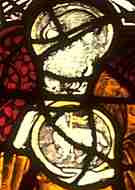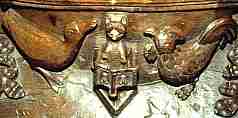




If you are looking at this page without frames, there is more information about medieval writing to be found by going to the home page (framed) or the site map (no frames).
| Bestiaries (2) | |||
| A selection of bestiary images displayed by the J. Paul Getty Museum gives a nice sample of the range and diversity of creatures and their symbolism. | |||
| The J. Paul Getty Museum images come from a Flemish bestiary of c.1270 (MS Ludwig XV3). F.46v shows Christ and a monk, a good shepherd with his sheep and an indolent goatherd who has allowed his flock to stray. | |||
 |
The lamb was equated with Christ himself, and sheep with the innocent. Goats could be regarded as representing sinners who had strayed, so the imagery of the above page is pretty straightforward. | ||
| John the Baptist carries the agnus dei, or lamb of God, symbol of Christ, in a stained glass window in the church of St Denys, York. | |||
| F. 68 of the same manuscript shows two lions and a cub on a mountainside. | |||
| The lion cub was purportedly born dead and was revived with artificial respiration by its mother. Thus it was like Christ who died and was resurrected. The accuracy of this natural history observation is about average for the bestiary. | |||
| F.78 of the manuscript depicts a siren and a centaur. | |||
| Two escapees from Greek mythology were each taken to represent sinful qualities, vanity and brutishness. | |||
 |
A corbel in Patrington church, Yorkshire, is carved in the form of a siren. We would call her a mermaid. | ||
| F.79v depicts a common creature of the hedgerows, a hedgehog. | |||
| The hedgehog is described as using its spines to impale grapes and carry them off for its young. By a convoluted logic it is depicted as a sinful animal, stealing the fruits of the labours of others and bristling with sins and vices. | |||
| F.89v depicts a creature called the apsidochelone. | |||
| The apsidochelone is one of the original creatures of Physiologus, with a scrambled Greek name. It is taken to refer to a whale, but is drawn in medieval bestiaries as a huge fish which lies very still on top of the water until sailors are deceived into thinking it is an island. When they land on it, it dives and drowns them as the Devil deceives sinners and leads them to their destruction. | |||
 |
Jonah is disgorged by the whale in a carving on a misericord in Ripon Minster,Yorkshire. | ||
| By escaping from the clutches of the whale, Jonah prefigures the resurrection of Christ. This whale is depicted as a large and ferocious fish, like those of the bestiaries. The characters of the creature of the Biblical story and that of the bestiary are as similar as their depictions. | |||
| The stories of the bestiary may seem absurd and indicative of profound medieval ignorance, but only if they are taken as an attempt at natural history recording. Undoubtedly they do not represent the genuine knowledge of medieval people about the natural world. The most illiterate villager knew that hedgehogs do not steal grapes on their spines, that badgers do not have a servant class that gets dragged around on their backs by other badgers, that weasels do not conceive through their ear and give birth through their mouth. In fact, the illiterate villager would have known a great deal about hedgehogs, badgers and weasels. | |||
| Perhaps people did believe some of the tales of more exotic creatures that they had never encountered, but there were pilgrims and crusaders, soldiers and sailors, craftsmen and princesses who had travelled outside their familiar home territory and who might have seen a whale but not an apsidochelone, a seal but not a siren, a camel but not a centaur. The bestiary stories were just that, stories. Animals featured in the oral tradition of storytelling from the dragons and monsters of ancient sagas to the mischievous tales of Reynard the Fox. It is only in modern times that we have relegated them to the realm of stories for children. | |||
 |
A fox stands in a pulpit and preaches to a duck and a chicken in a misericord carving from Ripon Minster. | ||
| Carvings like the above are not rare and may represent anti-clerical tales, often directed against the friars. And they put them in church. Animal antics could represent stories for adults. | |||
| The earnest clerics who collected, transcribed, annotated and embellished these stories were most unlikely to have been attempting to document the living world. After all, what use is a simplistic knowledge of animal behaviour to a priest or monk? That is the domain of the hunter, farmer, housewife or fisherman. The clerical scholars were studying and perpetuating the world of the written word. The value was not in natural history knowledge but in literacy itself, as they transcribed and transformed the works of the valued literate men of the past. Being churchmen, they turned this literate knowledge into lessons in Christian morality. The storytelling traditions that they employed were ones familiar to the congregations in the churches at the same time as they were reiterations of the written words of the past. | |||
 |
Some of the very lavishly illuminated bestiaries of the 13th century may have been prestige volumes for aristocratic lay owners. The inclusion of heraldic motifs in some illustrations gives a hint here. Variants on the animal imagery that put them into scenes of hunting, hawking or as the servants of armed knights are also suggestive. The bestiary imagery became part of medieval folklore and extended beyond the bounds of purely religious iconography. Today, when one is trying to dream up a quintessentially medieval image it will most likely involve a winged dragon, a griffon, a unicorn or a lion in heraldic pose. | ||
| A misericord carving in Lincoln Cathedral showing a lady with a unicorn. | |||
| This carving shows the bestiary tale of the unicorn which can only be captured if it can sit with its head in the lap of a virgin. This image was employed in that most aristocratic of late medieval art forms, the domestic tapestry. You could take your bestiary home in the form of a book, or high class furnishings. | |||
|
|
|||
|
|
|||
|
If you are looking at this page without frames, there is more information about medieval writing to be found by going to the home page (framed) or the site map (no frames). |
|||